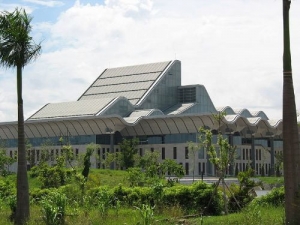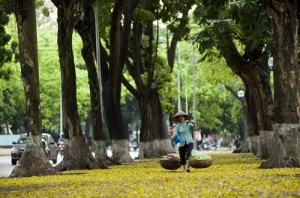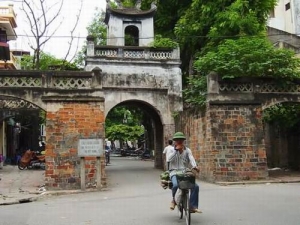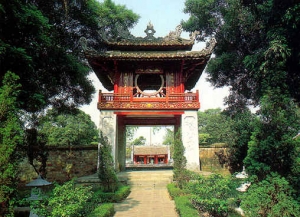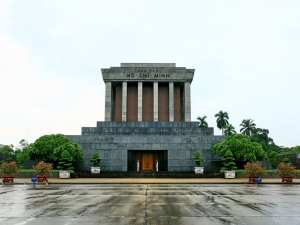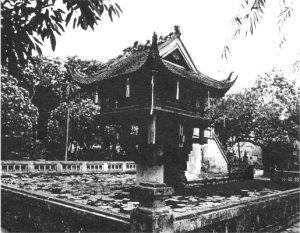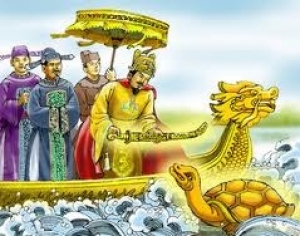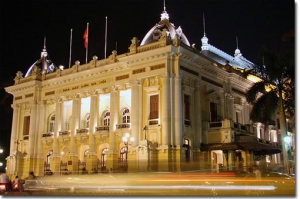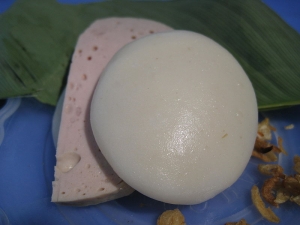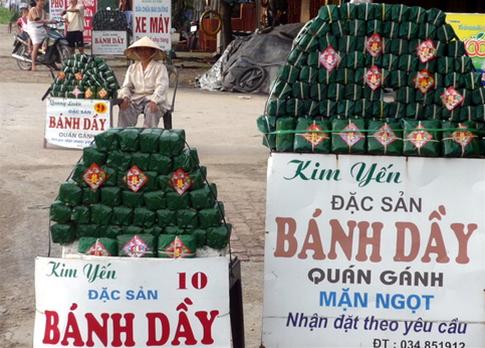
Asia Pacific Travel Team
Hanoi -A Political, economic and culture centre of the country
The Presidential Palace on Hung Vuong avenue where State-level ceremonies are held to welcome foreign Heads of State during their travel to Vietnam.

The Presidential Palace
Hanoi Flag Tower on Dien Bien Phu Street near the historical Ba Dinh Square.
 Hanoi Flag Tower
Hanoi Flag Tower
The house-on-stilt of President Ho Chi Minh in the Presidential Palace built in 1967 welcomes millions of visitors in Vietnam Tourism a year.

The House-on-stilt and Uncle Ho Fish Pond
President Ho Chi Minh's Mausoleum, inaugurated on August 28,1975, is an eternal resting place of the national liberation hero and world's outstanding cultural celebrity.

Ho Chi Minh mausoleum
Hanoi Opera House was built in 1901 and completed in 1911 as design of Paris Opera. it was restore in 1997.

Hanoi Opera House - A True Beautiful Building in Hanoi
Dong Xuan Market was built in 1890 in the present-day Hoan Kiem District. It regrouped two markets of the old Thang Long, i.e. Cau Dong Market and Bach Ma Market near the To River.
 Dong Xuan Marke - Wholesale Market in Hanoi
Dong Xuan Marke - Wholesale Market in Hanoi
The National Convention Centre was built in 2006. Its wave-like roof manifests the idea of Vietnam's integration into the world and looking towards the future.
Hanoi- an elegant and hospitable tourist city for peace
The millennial city of Hanoi, a city for peace, with its long-standing historical and cultural traditions, beautiful landscape and elegant people has attracted tourists from many parts of the world. In recent years, Hanoi Tourism has affirmed its key position in the capital's economic development. Hanoi, an elegant, hospitable and safe destination, has become a major tourist hub in Vietnam and the whole region as well.
 Hanoi in Autumn
Hanoi in Autumn
 Hospitable Hanoi
Hospitable Hanoi
Lang pagoda dedicated to TU DAO HANH, a true Buddhist from the Ly Dynasty, one among many relics of millennial Hanoi
 Lang Pagoda
Lang Pagoda
Van Mieu - Quoc Tu Giam (Temple of literature - the first National University) was built in 1076 in the retgn of King Ly Nhan Tong, having 82 steles inscribed with the names of 1,307 doctors, the most glorious symbol of Vietnam's academic education
 Temple of Literature
Temple of Literature

The house of doctoral steles in Temple of Literature

Hanoi festival in spring

Tet festival in Hanoi

Foreigners is shopping in Hanoi

Friendly Hanoi people

Beautiful and charming Hanoi girls
Long Bien Bridge - a Living Historical relic
“Hanoi” - the name means “surrounded by river” is the city of ponds, lakes, rivers and bridges. If Hoan Kiem Lake with special green water and the red bridge named The Huc is the symbol of an elegant and charming ancient city; Red river and Long Bien bridge may be seen as the symbol of courageous capital in wars.
History of Long Bien bridge
The Long Bien Bridge was constructed from 1989 to 1902 during French’s occupation of the country. Though the bridge was designed by French, it was built directly by Vietnamese workers with indigenous construction materials like woods from Phu Tho, Yen Bai, Thanh Hoa province, cement from Hai Phong, Long Tho lime from Hue.
The bridge was formerly named Paul Doumer by the French, but Vietnamese have called it Long Bien or Cai River Bridge for a long time, and Long Bien becomes the most popular name of the bridge. Originally, Long Bien had 19 spans and it was the first steel bridge across Red river in Hanoi, and one of four greatest bridges in the world at the time it was built.

Long Bien Bridge 's Construction
Long Bien was considered the pride, symbol of architecture in the Far East. The bridge was a connection point to transport tons of rice from Northern and Northern Central area of Vietnam to Dien Bien Phu battle, and contributed to the win of Vietnam army against French, 1954.
More than 100 years with decades of war, Long Bien Bridge was bombed many times by air attacks by American army in 1967, 1972; and many spans of the bridge were destroyed. The left spans still remaining today remind us of an unforgettable past. The bridge, hence, is not only a traffic construction, a nice architecture, but also a living historical relic.
Beautiful sights of Long Bien Bridge
Today, Long Bien is only one of the five bridges crossing the Red river of Hanoi. However, it may be the most special bridge with unique historic, architectural, and cultural value. It is the only bridge in Hanoi where all the riders have to go in the left hand side, where tourists can take a walk and taste mouthwatering desserts offered by vendors (see 5 street vendors you should not miss out in Hanoi), where Hanoians can buy fresh vegetable or fish for the dinner from the small afternoon market on the bridge.
Many people living and visiting Hanoi said that Long Bien Bridge is the best place to look at the sunrise or the sunset and taking nice photos of alluvial patch. Many brides and grooms choose Long Bien Bridge as nice background in their wedding albums. Many tourists come here to visit a historical construction and view nice scenery. Many youngsters, teenagers take nice photos to keep memories of youth on the bridge or in the middle of alluvial patch with full of green tree. Many vendors and housewives still come here every afternoon for an open air market.
And many trains pass the bridge each day.
That way, Long Bien – the oldest bridge in Hanoi is still living and sharing the daily life with Hanoians silently. If you have a chance to visit Hanoi, do not forget to take a walk on Long Bien Bridge for sight seeing, feeling the daily life of Hanoians, and enjoying peaceful moments at the present but not forgetting memorable past.
How to get there
You can rent a motorbike and remember go on the left hand side of the bridge, or walk from the centre of Hanoi to here ( just more then 1km from the Old Quarter to Long Bien bridge).
If tourists in Vietnam Travel have chance to visit Hanoi, Hoan Kiem Lake is a must-see place that should not be missed!
The Old Quarter - The Unique Classical Feature of Hanoi
There’s an old Vietnamese saying, “Hanoi has thirty-six streets and guilds – Jam Street, Sugar Street, Salt Street…”. Inside a modern and dynamic city, there appears an antique quarter, the Hanoi’s Old Quarter – the represented eternal soul of the city. These days, most Vietnamese and Westerners are familiar with the phrase “Hà Nội - Ba mươi sáu phố phường” (translated as “Ha Noi - 36 districts” or “Hanoi – 36 Old Streets”), or “Phố cổ Hà Nội” (translated as “Hanoi’s Old Quarter”), the top special historical vestige and sight-seeing of the capital, luring international visitors thanks to their mostly original state.
Temple of literature - the first national university of Vietnam
The very first stop-over of any foreign tourist in Hanoi is always Van Mieu-Quoc Tu Giam (translated as Temple of Literature), which reveals the Hanoians’ spirit of study in the past!
Situated at the south of Thang Long citadel, is on top of the historical and beautiful sightseeings of the beautiful capital of Vietnam. Please follow us in a brief tour of exploring his beauty and deep values.
historical temple of literature
Tourists, particularly the foreign ones, now flock to the site for taking a look into its profound traditional meanings of both a Confucion temple and the first university of Vietnam. Văn Miếu or Temple of Literature, known as "pagode des Corbeaux" during the period of French colonisation, was founded as a Confucian temple in 1070.
Only parts of the Văn Miếu complex date back to the earliest period, although much of the architecture dates to the Ly (1010 – 1225) and Tran (1225 – 1400) Dynasties. In 1076, Vietnam's first university, the Quốc Tử Giám (or National University), was established within this temple to educate Vietnam's mandarin class. The university functioned for more than 700 years, from 1076 to 1779, during which, 2,313 doctors graduated. Hence, the complex has been attached to the name of Van Mieu-Quoc Tu Giam up to now.
A beauty-spot of architectural values
This ancient Confucian sanctuary is now considered one of Hanoi's finest historical and cultural sites. “The ever special architetural style of Van Mieu dates back to the 11th century, evoking an inspiration of classical creativeness of many of us”, one of my tourists remarked. Just take a look into the art of architecture, you will share the feeling! The temple is based on Confucius' birthplace at Qufu in the Chinese province of Shandong. It consists of five courtyards lined out in order, entrance to the first, via the impressive twin-tiered Van Mieu gate leads to three pathways that run through the length of the complex. The centre path was reserved for the King only, the one to its left for administrative Mandarins and the one to its right for military Mandarins.

Well Of Heavenly Clarity
The first two courtyards are peaceful havens of ancient trees and well-trimmed lawns where the scholars could relax away from the bustle of the city outside the thick stone walls. Entrance to the third courtyard is through the dominating Khue Van Cac (constellation of literature), a large pavilion built in 1802. Central to the this courtyard is the Thien Quang Tinh ("Well Of Heavenly Clarity"), either side of which stand two great halls which house the true treasures of the temple. These are 82 stone steles. Another 34 are believed to have been lost over the years. They sit upon stone tortoises and are inscribed with the names and birth places of 1306 men who were awarded doctorates from the triennial examinations held here at the Quoc Tu Giam ("National University") between 1484 and 1780, when the capital was moved to Hue.

Doctor stelae - Temple of literature
The fourth courtyard is bordered on either side by great pavilions which once contained altersl of 72 of Confucius greatest students but which now contain offices, a gift shop and a small museum which contains ink wells, pens, books and personal artifacts belonging to some of the students that have studied here through the years. At the far end of the courtyard is the altar with statues of Confucius and his four closest disciples. The fifth courtyard contained the Quoc Tu Giam, Vietnam's first university founded in 1076 King Ly Can Duc, but this was destroyed by French bombing in 1947.
Though having gone through lots of restoration work, the temple still retains its very first original shape, to be one of the visit-worthy sightseeings of Hanoi, captivating to a huge number of tourists elsewhere.
In the run-up to the Vietnamese New Year celebration, calligraphist tend to assemble outside the temple and write wishes in Hán tự, which are popular amongst Vietnamese as gifts or to be used as decoration at home for auspicious occasions.
A space of peace, green trees and solemnity covers the whole temple of historical and traditional love for study, making tourists feel like they were lost in a land of Confucion and traditional values. If you are in Hanoi, you should really come and explore it yourself!
If tourists in Vietnam Travel have chance to visit Hanoi, Temple of Literature is a must-see place that should not be missed!
Ho Chi Minh Mausoleum - a symbol of gratitude and respect of Vietnamese people
Construction work began on September 2, 1973 and the structure was formally inaugurated on August 29, 1975. The mausoleum was inspired by Lenin's Mausoleum in Moscow but incorporates distinct Vietnamese architectural elements, such as the sloping roof. The exterior is made of gray granite, while the interior is gray, black, and red polished stone. The mausoleum's portico has the words "Chủ tịch Hồ Chí Minh" inscribed across it, meaning "President Ho Chi Minh."
In his will, Ho Chi Minh stated his wish to be cremated and to have his ashes scattered in the hills of north, central, and southern Vietnam. He said that he preferred cremation because it would be "more hygienic than burial and would also save land for agricultural purposes." The mausoleum was built in spite of his wishes.
Ho Chi Minh Mausoleum
The structure is 21.6 metres high and 41.2 metres wide. Flanking the mausoleum are two platforms with seven steps for parade viewing. The plaza in front of the mausoleum is divided into 240 green squares separated by pathways. The gardens surrounding the mausoleum have nearly 250 different species of plants and flowers, all from different regions of Vietnam.

Ba Dinh square
Ho Chi Minh's body is preserved in the cooled, central hall of the mausoleum, which is protected by a military honour guard. The body lies in a glass case with dim lights. The mausoleum is closed occasionally while work is done to restore and preserve the body but is normally open daily from 9:00 am to noon to the public. Lines of visitors, including visiting foreign dignitaries, pay their respects at the mausoleum.
Around Ho Chi Minh Mausoleum
The grandeur of the mausoleum is a strange contrast to the simple stilt house where Ho Chi Minh lived and worked. Built in the style of ethnic minority dwellings, it overlooks a large carp pond and is a calm sanctuary. Visitors can look through the windows to see the austere furnishings and his few personal possessions. On his desk each day is a vase of his favourite blossoms, hoa hue trang, a sweetly scented flower rather like a tall white bluebell.

Uncle Ho House and fish pond
Nearby is the magnificent Presidential Palace, once the palace of the Governor-General of Indochina during the colonial period. Unfortunately, it’s not open to the public.
In the opposite direction, the Ho Chi Minh Museum provides a comprehensive overview of the man’s life and work and his vision of peace and happiness. It’s informative, but understandably overlooks some of the more risqué episodes in his life. Close by, the famous One Pillar Pagoda is worth a passing look. Although it’s one of the symbols of Hanoi, it’s something of a disappointment as it’s a modern replica.

One pillar pagoda
The Ho Chi Minh Museum is open from 08.00 to 11.00 and from 13.30 to 16.30 daily.
A short walk across Da Dinh Square directly in front of the mausoleum takes you past the Tomb of the Unknown Soldier, a stunningly beautiful monument especially when illuminated at night. From there, another short walk takes you to the Hanoi Citadel.
The mausoleum is the last resting place of Ho Chi Minh. It is a symbol of gratitude and respect of Vietnamese people for president Ho Chi Minh.
If tourists in Vietnam Travel have chance to visit Hanoi, Ho Chi Minh mausoleum is a must-see place that should not be missed!
One Pillar Pagoda - The most unique architecture in Vietnam
According to legend, ageing Emperor Ly Thai To of the Ly dynasty, who had no children, used to go to pagodas to pray to Buddha for a son. One night, he dreamt that he was granted a private audience to the Bodhisattva Avalokiteshvara, who was seated on a great lotus flower in a square-shaped lotus pond on the western side of Thang Long Citadel, gave the King a baby boy. Months later, when the Queen gave birth to a male child, the Emperor ordered the construction of a pagoda supported by only one pillar to resemble the lotus seat of his dream in the honour of the Bodhisattva Avalokiteshvara. According to a theory, the pagoda was built in a style of a lotus emerging out of the water.
In the past, One-Pillar Pagoda was located in Thanh Bao Village, Quang Duc District in the west of Thang Long Citadel under the Ly Dynasty. According to Dai Viet Su Ky Toan Thu (A Complete History of Great Viet), the pagoda was built in the winter of 1049 under the reign of King Ly Thai Tong who dreamt of seeing the Goddess of Mercy sitting in a lotus throne and taking him to it. When waking up, the king told mandarins about his dream and one of them thought that it was a bad omen. Monk Thien Tue advised him to build a pagoda and a lotus-shaped tower like what he saw in his dream. When the pagoda was inaugurated, monks went around the pagoda and recited the Buddhist scriptures to pray for longevity of the king. For this reason, the pagoda is also called Dien Huu (long lasting happiness and good luck).

One Pillar pagoda - HaNoi
During the Ly Dynasty, the pagoda was the site to hold an annual ceremony on the occasion of Buddha Day - Vesak. In addition, on the 8th day of the 4th lunar month, the king and people visited the pagoda to participate in Buddha-bathing and release ceremonies.
After being repaired many times, the pagoda was destroyed by the French colonists in 1954. In 1955, the government has the pagoda rebuilt. The present wood pagoda is in the shape of square with each side of 3m and a curved roof. It was designed to resemble a lotus stretching up out of the square pond and placed on a big stone pillar including two blocks which are connected together skillfully. This stone pillar is approximately 4m high (excluding the underground section) and 1.2m in diameter. The pagoda structure also shows the harmonious combination of imagination and unique architecture with a system of wood beams that create the solidity and beauty for the pagoda.

With its architectural and historical values, the One-Pillar Pagoda was classified as a historical relic on April 28, 1962. On May 4, 2006, it was recorded in the Vietnamese Guinness Book as The pagoda with the most unique architecture in Vietnam.
Nowadays, One pillar pogoda has become one of the most delightful architectural complexes in Hanoi, attracting a large number of domestic and foreign tourists. The pagoda is open daily from 8h00 a.m. to 5h00 p.m. Entrance is free.
If tourists in Vietnam Travel have chance to visit Hanoi, One pillar pagoda is a must-see place that should not be missed!
The legend of Hoan Kiem Lake
Hoan Kiem lake means “lake of the returned sword”. This name is related to the famous historical legend of King Le Thai To. And before this legend, Hoan Kiem Lake used to be called Luc Thuy Lake (or Green Water Lake) since the water was green all the year round. In 15th century, it was named Hoan Kiem Lake after the legend of Emperor Le Thai To, which is somehow similar to the story of King Arthur and the Lady of the Lake's.
Hanoi Opera House - Truly a Beautiful Building in Hanoi
Looking down Trang Tien Street, you can see Hanoi Opera House standing strongly, deserving to be one of Hanoi's grandest buildings.
Built by the French in 1911, and renovated in the late 1990s, this is an incredible building. Hanoi Opera House is an old theatre with French architecture and typical Gothic and Mosaic characters reflected on the door domes and the glassed room respectively. The facade is colonial French with pillars and balconies overlooking the city center. The 900-seat opera house plays host to visiting foreign performances as well as Vietnamese symphonies. The exterior is a delightful mix of French neo-classical design with shuttered windows, wrought iron balconies and tiles friezes.

For a long time, Hanoi Opera House has been a rendezvous for those who love theatrical performance and traditional songs and music, symphonies, opera and classical opera. It is also a tourist attraction for local and foreign visitors.
History of Hanoi Opera house
Hanoi Opera House is a great construction built by the French Colonialist Government during the early years of the 20th century. Harley and Broyer were designers. This design was much modified by ideas of some architects. The work was started on june, 7th, 1901, undertaken by a local supervisor - Harley Architect. Mr Travary and Savelon were in charge of the construction. The work, the peak of which is 34 meters above the ground, was carried out in a total area of 2600 square meters with the 87-meter length and 30-meter width. The designers consulted Corankta Greek ancient architecture in combination with Tuylory Castle and Opera de Paris to form a unique architecture.

Hanoi Opera House has a great value in history, architecture as well as its use. It was a historical evidence of Vietnamese social and cultural development under French rule, a vestige for an architectural development stage dating back to the end of the 19th and early 20th centuries in Vietnam. The theatre has seen many significant historical events associated to the August Revolution and the early years of Vietnam Democratic Republic.
Striking characteristics
Hanoi Opera House is renowned for its unique architecture and good composition. It is furnished rationally and harmoniously. Since its establishment, Hanoi Opera House is the largest theatre in Vietnam.
Previously the site was a big pond, adjacent to the city gate of Tay Long (also called Tay Luong) of the ancient Thang Long Capital. The construction met with many difficulties, because the foundations of the theatre were built on the pond. Before building a concrete foundation, nearly one metre thick, the pond was emptied and dredged, then 30,000 hard bamboo stakes were placed on its bed.
Hanoi Opera House is of the same architectural style as the Opera House in France. Some foreign architects said that due to being built nearly 300 years after the Paris Opera House, Hanoi Opera House avoids superfluous architectural details, which make it more magnificent and attractive. Inside the opera house are a large stage and a main audience room with a size of 24x24m, with many small rooms for audience on the central floor. The middle staircase leads to a large Hall on the second floor. The sub-staircase and corridors are located in both sides.
At the back of the Opera House is a management chamber consisting of 18 make-up rooms, 2 rooms for voice training, 1 library and 1 meeting room. Facing the stairs is a magnificent mirror room on the second floor. Opera house has been so far a typical, large-scaled art showing place, wherein party state meetings and international conferences are held. It is considered a cultural work with the best value in Vietnam, a unique architectural work with great historical, cultural, architectural and fine-art value, a unique works in urban area as well as in the capital city. The theatre has been equipped with state-of-art facilities and appliances, compatible for all types of artistic performances, from folk music and songs, ballets and piano to classical opera, reformed opera, Vietnamese operetta and drama, all made great impressions on the audience. Hanoi Opera House has also successfully organized many large-scale international concerts.

Being an ancient architecture work, the Opera House is now becoming a national art work of international renown, which contributes to our country's modern cultural field, also serves as a foundation in cultural exchanging, in our present social economic development and the national cultural innovation in particular.
Hanoi Opera House is a worthy artistic centre, a cultural and architectural relic of the capital Hanoi. This is truly a beautiful building in Hanoi and the best place to see the Opera House is from the 6th floor of the Hanoi Hilton.
If tourists in Vietnam Travel have chance to visit Hanoi, Hanoi Opera House is a must-see place that should not be missed!
Quan Ganh village serves best "Banh Day" - Glutinous rice cake
Located along National Highway No.1 in Hanoi's Thuong Tin District. Quan Ganh village is worth for a visit just to sample some of the local Banh Day or Day cake.
Day cake is similar to chung cake, which is eaten during the lunar year, but day cake is a popular snak throughout the year.
Chung and Day cake are closely connected to Lang Lieu, a Vietnamese prince. According to legend, a beggar once came to Quan Ganh. The villagers did not drive him away, and instead fed him a hearty meal. In return, beggar taught the villagers how to make Day cake. From then on, villagers have been enjoying the snack.
Quan Ganh village makes the best Day cake in Hanoi, an it can be easily found on sales by treer vendors for just a few thousand Vietnamese dong.
This cake is made with a special kind of glutinous rice which can only be planted in Hai Hau (Hải Hậu), Nam Dinh (Nam định) province. It is greatly fragrant and glutsive role in making good cakes.


